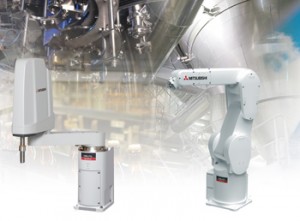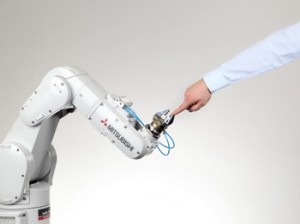Human-robot collaboration and Industry 4.0
 At this year’s Hannover Messe, Mitsubishi Electric and partners presented hands-on handling and automation solutions, with robotic highlights from quality control through to pick and place applications and systems for handling delicate goods
At this year’s Hannover Messe, Mitsubishi Electric and partners presented hands-on handling and automation solutions, with robotic highlights from quality control through to pick and place applications and systems for handling delicate goods
One particular high speed application was based on the new RH-1FHR MELFA robot which is used by Bahr Modultechnik in a camera-supported system for sorting pharmaceutical packaging between a conveyor belt and a linear axis.
Datalogic from the e-F@ctory partner network presented a robot solution with various vision systems, a laser marking system and its own safety technology. The partner applications also included a complete solution from Robotronic AG specially designed for handling in the pharmaceutical and life science sector. In the compact, modular MRT cell, two six-axis robots are both responsible for handling the syringes and are capable of operating at a processing rate of up to 600 syringes per minute.
Human-Robot Cooperation
Mitsubishi Electric has made many developments in order to promote Human-Robot Cooperation (HRC), especially in connection with safety and control technology as well as intelligent robot technology. “Mitsubishi Electric robots continue to make their mark with maximum speed and precision,” says Oliver Giertz, European product manager for servo/motion systems and robots at Mitsubishi Electric Europe. “However, the full performance capability has not been achieved yet within HRC. There is a high potential for innovation within the field of assistance in production in particular.”
 Of the innovative developments presented by the MELFA robots within this area, Giertz says: “Above all, the ability to detect people prior to contact will increase the efficiency of such systems. Our robots are also easy to program and commission. However it is also clear that no matter how much a robot may resemble a human in the way it looks and acts, operating personnel will always be required in order to allocate tasks. Only then can a robot with all its technical benefits assist with production.
Of the innovative developments presented by the MELFA robots within this area, Giertz says: “Above all, the ability to detect people prior to contact will increase the efficiency of such systems. Our robots are also easy to program and commission. However it is also clear that no matter how much a robot may resemble a human in the way it looks and acts, operating personnel will always be required in order to allocate tasks. Only then can a robot with all its technical benefits assist with production.
“Another challenge facing HRC technology is the need to tap into new professional fields and industries,” he continues. “In the medical sector, it could be used to provide assistance during operations or in laboratory automation or the production of individual components, for example.
HRC and Industry 4.0
Thomas Lantermann, senior business development manager at Mitsubishi Electric Europe, adds: “HRC will also continue to be developed in connection with Industry 4.0 as it can be used to increase flexibility within the production process. The aim is for robots to be used specifically, regardless of the environment or task. In the production process, Industry 4.0 can help to make comprehensive systems controllable through the application of assistance systems.
“A robot will be able to support or even carry out complex, high-precision fitting or assembly processes. It can collect the information required for traceability, preventive maintenance, quality assurance and energy management and forward it to the MES/ERP system from where it can be made available to the whole value chain. Robots are predestined to be used in the manufacture of personalised products and also to work effectively and efficiently, even with the smallest of quantities.”
Visit the Mitsubishi Electric website for more information.
See all stories for Mitsubishi Electric
Download the Hannover Messe 2015 robotics review here (PDF 1Mb).
Previous page Hannover Messe 2015 report Next page















